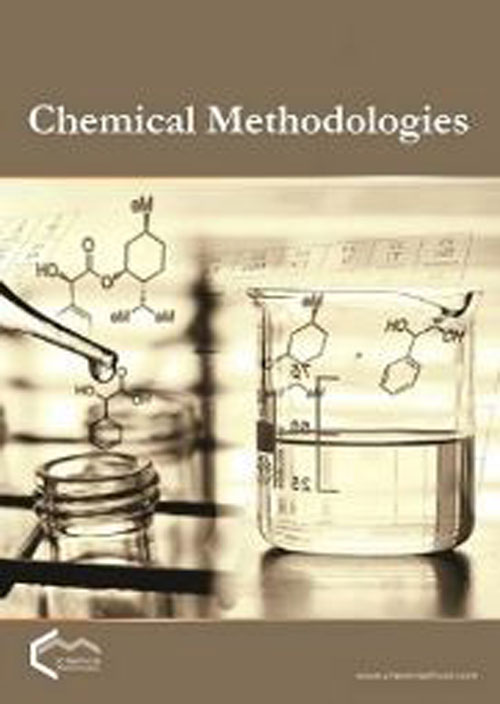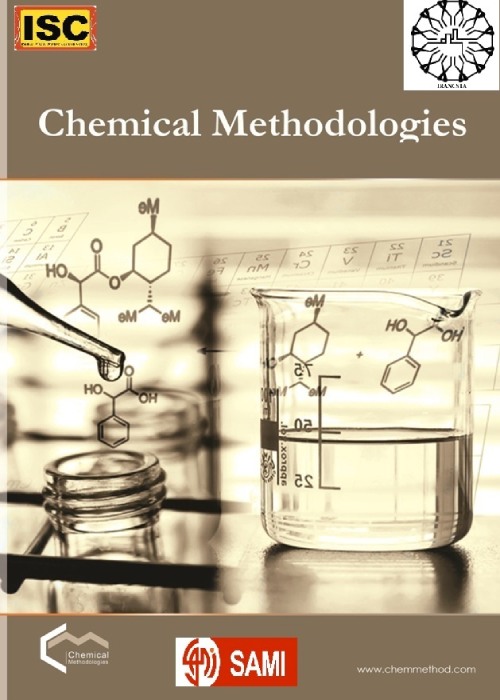فهرست مطالب

Chemical Methodologies
Volume:5 Issue: 3, May-Jun 2021
- تاریخ انتشار: 1400/02/19
- تعداد عناوین: 8
-
-
Pages 211-218
Fluoxetine (N-methyl-c-[4-phenoxy] benzene epropanamine) (FLU), the main drug in the antidepressant class is serotonin reuptake inhibitor (SSRI), which has emerged as a therapeutic advancement in psychiatry. It has been shown to be effective in treating depression worldwide and has also been shown to be much more effective in treating other syndromes, such as bulimia nervosa, panic attacks, and obsessive-compulsive disorder. An instrumental setting including off-line solid phase microextraction with spectrophotometry has been developed to improve the sensitivity of fluoxetine quantification in real samples. This method was used to analysis wastewater specimens with 89.9% recovery. This research is a review of new developments in substances and format technology that lead to the extraction of semi-polar compounds in various extraction methods. This mainly consists of a solid phase µ-extraction, using a simple silver nanoparticle. The use of µ-extraction conditions such as pH, salt effect, yield and desorption conditions are examined. This procedure has a high enrichment factor and excellent sample selection cleaning. Reasonable relative improvement was also obtained. Linear calibration curves were obtained in the range of 0.1-35 mg L-1. We have used this method to clean up and pre-concentration of fluoxetine from factual samples.
Keywords: fluoxetine, Silver nanoparticles, Solid-phase micro-extraction, FLU -
Pages 219-226
Curcumin and its nano-phytosome have anti-inflammation and antioxidant properties that may decrease the concentration of metabolic factors, inflammatory parameters and anxiety in stressed rats. However, the effects of administration of of curcumin on inflammation and anxiety have not still been investigated. This study was conducted to scrutinize the metabolic factors, anxiety-like behavior and inflammatory factors in rats exposed to stress and treated with nano-phytosome of curcumin. Eighty femalerats were divided into four groups (n=20), including 1 and 2) non-stressed rats treated with saline (negative control) and nanophytosome (N-nano), 3 and 4) stressed rats treated with saline (Positive control) and nanophytosome (P-Nano). The rats in stressed groups were exposed to stress for 13 days and then treated for 21 days. Anxiety‑like behavior and inflammatory factors of IL-6, IL-1β, TNF-α and COX-2 and the concentration of glucose and triglycerides were assessed following the treatment with nano-phytosome. The results showed that the induction of stress increased anxiety symptoms (p <0.05), the inflammation (p <0.05) and blood parameters (p <0.05), but the treatment with nano-phytosome of curcumin reduced anxiety symptoms (p <0.05), the inflammation (p <0.05) and blood parameters (p <0.05). Overall, the induction of stress caused the inflammation and anxiety and increased the concentration of glucose and triglycerides. However, the treatment of the rats with nanophytosome of curcumin reduced adverse effects of the stress on inflammation and anxiety paramters. This study showed positive effects of curcumin for decreasing the inflammation and anxiety in the stressed rats, but clinical studies are required for its confirmation on human.
Keywords: Stress, Rats, anxiety, Inflammation, blood parameters -
Pages 227-233Due to the increasing use of drugs and growing environmental pollution, controlling the use of drugs and the ability to measure their small amount is an issue of great significance. The present study examined the determination of low amounts of propanolol based on solid phase microextraction method via spectrophotometry. In this work, the adsorbent was made on the basis of multi-walled carbon nanotubes supported by magnetic nanoparticles (MWCNT), followed by optimization. Various factors such as pH, organic solvent adsorption volume, extraction and desorption time, stirring rate and solvent type were examined for the purpose of optimization. For this objective, a spectrophotometer was used to obtain the maximum wavelength of propanolol (214 nm) and to obtain the optimal conditions. The dynamic range was 0.02-0.35 mg/l. In addition, pre-concentration values, LOD and% RSD were 268.28, 0.022 mg/L and 1.76, respectively.Keywords: Removal, Propanolol, Multi-walled carbon nanotube, micro solid phase extraction, Magnetic nanoparticle
-
Pages 234-239
In this research, an amplified sensor based on paste electrode (PE) modified with MgO nanoparticle (MgO/NPs) and 1-hexyl-3-methylimidazolium hexafluorophosphate (HMH) was designed and used for determination of methyldopa (MD). The CP/MgO/NPs/HMH showed good catalytic activity toward oxidation of MD and improved drug current about 3.58 times. In addition, CP/MgO/NPs/HMH showed a diffusion process and pH dependence behavior for electro-oxidation of MD in aqueous solution. However, differential pulse voltammogram of CP/MgO/NPs/HMH showed a linear dynamic range to sensing of MD in concentration range 1.0 nM – 400 µM with detection limit 0.5 nM. The recovery range 98.25% - 102.5% was obtained for sensing of MD in real samples using CP/MgO/NPs/HMH.
Keywords: Methyldopa, MgO nanoparticle, Ionic Liquid, 1-hexyl-3-methylimidazolium hexafluorophosphate, Sensor -
Pages 240-249The recent trend of using natural products from the plants, either as pure constituents or as standardised extracts, provides many opportunities for novel drugs, precisely the wild edible plants. The Adansonia digitata is considered one of the most important therapeutic and nutritional wild edible plants because of bioactive compounds existing in the seed oil; therefore, this study investigated the petroleum ether and methanol seed oil extracts via using two analytical methods [GC-MS, and FTIR spectrometer]. The seed oil was extracted by using Soxhlet apparatus. The GC-MS analysis of A. digitata seed oil showed thirty-five compounds. About twenty-four of them showed peak Area > 1%, The major compounds were eight, they showed peak area% (2.6%-1508%), namely Hexadecanoic acid, methyl ester, 9-Octadecenoic acid, methyl ester, (E), 9, 17-Octadecadienal, (Z), 9, 12-Octadecadienoic acid (Z, Z)-, methyl ester, Diethyl malonic acid, monochloride, hexadecyl ester, Malonic acid, 4-heptyl propyl ester, 9-Octadecenal, and (Z), 13-Tetradecen-1-ol acetate, while the FTIR spectrum showed functional groups for alcohols, phenols, alkanes, alkenes, carbonyls and Carboxylic acids and aromatic compounds in the petroleum ether and methanol extracts with different absorbance bands and their correspondences. The GC-MS and FTIR analysis showed the availability of bioactive compounds in the plant extracts, and these ingredients may be responsible of pharmaceutical value of the A. digitata plant.Keywords: Adansonia digitata, GC-MS analysis, Novel drugs, therapeutic, Nutritional
-
Pages 250-258A rapid and selective dispersive solid-phase extraction technique, by the combination of Fe3O4@MWCNT-amine nanoparticles with HPLC (high-performance liquid chromatography), was expanded to detect the fluoxetine trace amounts in biological samples. The effective parameters on fluoxetine extraction were investigated by Fe3O4@MWCNT-amine, and the optimum conditions for fluoxetine extraction were sample pH 10.0, adsorption time of 28 min, and eluent (acidic methanol). Under the optimum extraction conditions, the limit of quantification (LOQ) and detection of limit (LOD) were found to be 18 and 6 µg L-1, respectively. Likewise, a linear range method with the concentration of fluoxetine in the range of 40−800 µg L-1 was applied. The analysis of several biological samples such as human plasma, urine, and tap water samples was successfully performed by applying the SPE method, which is an easy and sensitive method and an appropriate alternative for the analysis of fluoxetine.Keywords: fluoxetine, Fe3O4@MWCNT, SPE, Dispersive solid phase extraction, HPLC-UV detection
-
Pages 259-270
To develop the lead-free organic perovskites, the crystal CH3NH3SnBr3 was selected for their computational exploration which has a vast functional application in optoelectronic area as functional materials.First of all, the electronics band structures, the total density of state, the partial density of state and optical properties were investigated by DFT functional for CH3NH3SnBr3. In general, the band gap of CH3NH3SnBr3was calculated at 1.421 eV by Generalized Gradient Approximation (GGA) with Perdew Burke Ernzerhof (PBE) functional, and the energy gap and open circuit voltage was evaluated. The density of states (DOS) and partial density of states (PDOS) were evaluated to show that how each atom can be contributed to their electronic structure. The optical properties, for instance absorption, reflection, refractive index, conductivity, dielectric function, and loss function were estimated.Further, Sn atom was substituted to design the lead-free molecule, CH3NH3SnBr3 that passed good optoelectronic and optical properties. It can be concluded that Sn atoms containing organic crystal, CH3NH3SnBr3, show narrow band gap in comparison to lead or other heavy metals containing crystals although Sn is smaller in atomic size than Pd atom.
Keywords: Band gap, DoS, PDOS, optoelectronics, organic perovskites -
Pages 271-284
Iron–benzenetricarboxylate metal-organic frameworks were prepared chemically in the present study. For this purpose, using iron (II, III) chloride and trimesic acid, the nano metal-organic ramework was synthesized and then was identified and characterized by scanning tunneling electron microscopy, X-ray diffraction analysis, Fourier transform infrared spectrogram, ultraviolet, and N2 adsorption and desorption (Brunauer-Emmett-Teller and Barrett- Joyner-Halenda) techniques. The structure, morphology, purity, and crystallinity of the metal-organic framework were also investigated. The framework was employed to remove lead from wastewater and the effect of different parameters, including absorbent concentration (0.2-0.5 mg/L), pH (3.5-12.5), temperature (10-75 °C), and lead concentration (10-150 mg/L), on lead removal was investigated. The maximum efficiency, as 100% lead removal, was obtained with 0.25 mg/L of BTC-Fe adsorbent at 50 °C and a pH of 3.4. Due to the features of the employed adsorbent, such as magnetic effects, reusability, large surface area, low cost, and high efficiency, it can be suggested as an ideal option for the removal of lead.
Keywords: Lead, Trimesic acid, Organic Metal, Wastewater Treatment


